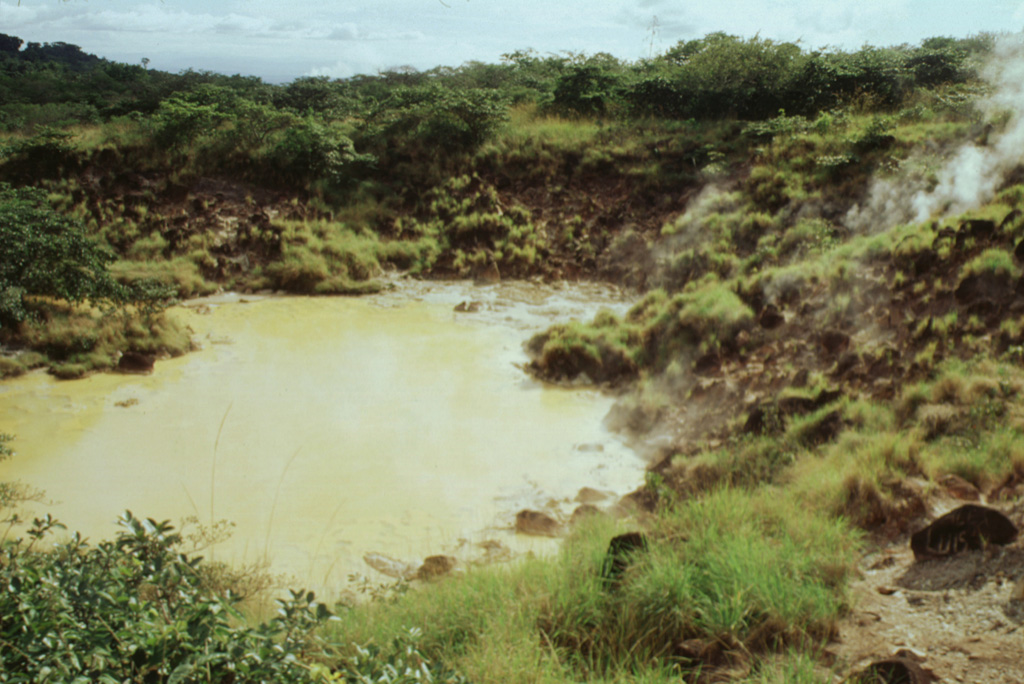Featured image: Steam rising from a pool in the Aguas Termales area near the base of Rincón de la Vieja volcano in Costa Rica. Courtesy of the Global Volcanism Program, Smithsonian Institution; photo by Paul Kimberly.
Paper: Effect of tectonic processes on biosphere-geosphere feedbacks across a convergent margin
Authors: K. M. Fullerton, M. O. Schrenk, M. Yucel, E. Manini, M. Basili, T. J. Rogers, D. Fattorini, M. Di Carlo, G. d’Errico, F. Regoli, M. Nakagawa, C. Vetriani, F. Smedile, C. Ramirez, H. Miller, S. M. Morrison, J. Buongiorno, G. L. Jessen, A. D. Steen, M. Martinez, J. M. de Moor, P. H. Barry, D. Giovannelli, and K. G. Lloyd
Plate tectonics describes the workings of our planet on the gigantic scale of continents and oceans, moving graduallly over hundreds of millions of years. But the tectonic processes that slowly shape and reshape the whole surface of the Earth also directly influence the lives of some of our planet’s tiniest residents: microbes. And those microbes, in turn, may have a larger effect on Earth’s carbon cycle than previously estimated.
In a new study, Fullteron and co-authors sampled water from hot springs in Costa Rica at a variety of locations above an active subduction zone, where an oceanic plate is diving beneath the continent and returning to the Earth’s mantle. Subduction zones are intense places, tectonically speaking, where rocks are deformed as two plates converge and lots of heat and fluids circulate through the system.
Fullerton and colleagues found that both the microbial communities and the water chemistry in the Costa Rican hot springs varied systematically in relation to the tectonic structure of the subduction zone. Dissolved concentrations of elements and compounds including magnesium, calcium, sodium, chlorine, and sulfate, were distinct for different areas. This reflects the different pathways that geothermal fluids can take from a subducting plate up through the continent above, depending on the depth of that subducting plate below a given hot spring location.
As the fluid chemistry changed, so did the microbes. Metagenomic analyses, looking at the overall mix of genetic material present in each water sample, showed that particular genetic markers were correlated with the water chemistry. Microbes that live off of energy gleaned from the oxidation of sulfur or iron, for example, lived in the springs where those compounds were most abundant. By analyzing the microbial genetic markers, the researchers concluded that the majority of the microbes were living off of carbon dioxide that came from the subducting plate and circulated in geothermal fluids through the overriding continent.
Subduction zones are integral parts of global biogeochemical cycles: they move immense amounts of material between Earth’s surface and its interior, including water, carbon, and other substances that living organisms need. Fullerton and co-authors’ detailed study shows that this subduction zone cycling supports large and complex subsurface microbial communities that, by sequestering some of the carbon released from the subducting plate, could play an important role in the global carbon cycle.
Microbes, tectonics, and the global carbon cycle by Hannah Mark is licensed under a Creative Commons Attribution-ShareAlike 4.0 International License.

